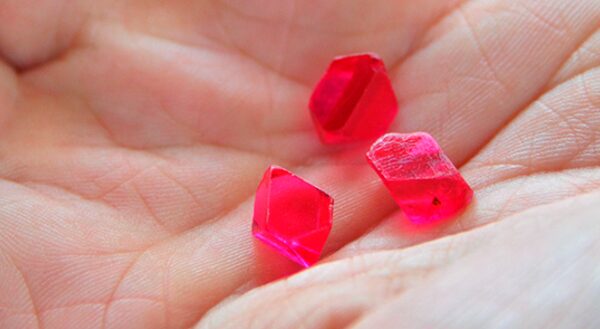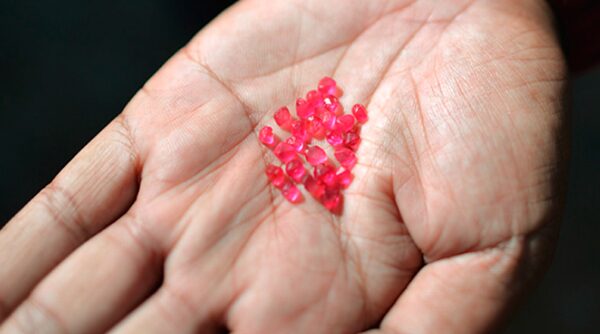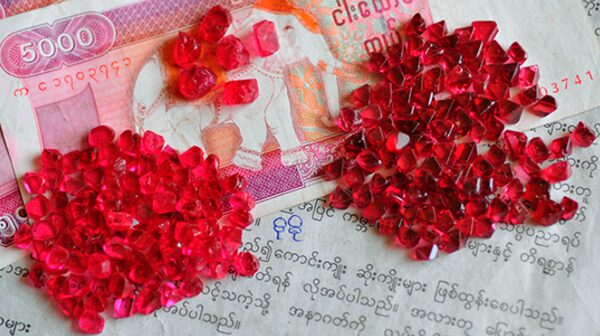Jedi spinels are rare and prized for their vibrant colors. These gems from Mogok, Myanmar, shine with an intense neon glow. Their unique properties make them a favorite among gem enthusiasts.
| Bright Neon Red Jedi Spinels Crystals |
|---|
 |
| Fraîcheur et délices (Cool and delicious): These vibrant neon red spinel crystals originate from Man Sin, Mogok. Photo by Vincent Pardieu, © GIA. Image Source https://www.gia.edu/gems-gemology/spring-2014-pardieu-jedi-spinels-in-mogok |
Table Of Contents
- 1) What Are Jedi Spinels?
- 1.a.) History and Origin of the Term “Jedi Spinel”
- 1.b.) Defining Characteristics of Jedi Spinels
- 1.c.) The Role of Chromium and the “Dark Side” in Spinels
- 1.d.) Comparing Jedi Spinels to Other Gemstones
- 2) Where Are Jedi Spinels Mined?
- 2.a.) The Mystique of Mogok: Myanmar’s Legendary Mines
- 2.b.) Mining Methods in Mogok and Their Impact on Gem Quality
- 2.c.) Other Notable Locations for Mining Jedi Spinels
- 2.d.) Nat Thwe: Spirit-Polished Spinels with Spiritual Roots
- 2.e.) Mining Today: Artisanal Labor, Kanase Women, and Export Challenges
- 2.f.) Famous Jedi Spinel Jewelry: Smithsonian Bracelets and Collector Gems
- 3) What Makes Jedi Spinels Exceptional?
- 3.a.) The Unique Chemical Composition of Mogok Spinels
- 3.b.) Understanding Inclusions and Their Effects on Value
- 3.c.) The Impact of Neon Color and High Saturation
- 4) How Do Gemologists Evaluate Jedi Spinels?
- 4.a.) GIA Standards and Certification
- 4.b.) Assessing Clarity, Cut, and Color
- 4.c.) Comparing Natural vs. Synthetic Spinel
- 4.d.) AIGS Grading System: Setting the Jedi Standard
- 5) Frequently Asked Questions About Jedi Spinels
|
|
1) What Are Jedi Spinels?Back To Top |
Jedi spinels showcase vivid colors and strong fluorescence. These gems exhibit bright red to pinkish-red hues. The term “Jedi” highlights their almost supernatural glow, reminiscent of the lightsabers in Star Wars.
|
|
1.a) History and Origin of the Term “Jedi Spinel”Back To Top |
Vincent Pardieu, a well-known gemologist, popularized the name “Jedi spinel.” He first used it to describe these strikingly vibrant stones from Myanmar. The term caught on quickly among collectors and traders due to its catchy and fitting nature. Jedi spinels primarily come from the Man Sin mine in Mogok, a region famous for its gem-quality spinels.
Back in the early 2000s, renowned field gemologist Vincent Pardieu visited Myanmar and encountered a batch of spinels so intensely vivid, they looked like they were lit from within. These hot-pink to red gems glowed under UV light like nothing he’d seen before.
Inspired by the bright lightsabers from Star Wars, Pardieu jokingly called them “Jedi Spinels”—gems so pure and radiant, they seemed untouched by the “dark side.” The nickname caught on fast in the gem trade, especially since these stones lacked the iron content that usually darkens red spinels. Since then, “Jedi Spinel” has become a shorthand for neon brilliance and purity in red spinels from Myanmar.
|
|
1.b) Defining Characteristics of Jedi SpinelsBack To Top |
Jedi spinels are famous for their bright neon pink to red colors. These fluorescent spinels are low in iron but rich in chromium, giving them intense fluorescence. This fluorescence is particularly strong under UV light, making the gems appear to glow. The presence of certain trace elements like vanadium and zinc also contributes to their unique color and brilliance. Unlike other spinels, Jedi spinels do not show dark tones, maintaining a consistent and vivid color throughout.
|
|
1.c) The Role of Chromium and the “Dark Side” in SpinelsBack To Top |
Jedi Spinels owe their glow to chemistry—specifically, chromium in spinel. This trace element gives them their vivid red and pink fluorescence. It’s the same element responsible for ruby’s red, but in spinel, the effect can look even brighter.
What keeps a spinel glowing like a lightsaber? Low-iron spinel. Iron is the killjoy here. It darkens color and blocks the fluorescence. That’s why Jedi Spinels are often called fluorescent spinels—they light up under UV light and sunlight alike.
When comparing a red spinel vs ruby, Jedi Spinels tend to be brighter, more neon, and free of the murky undertones that iron adds. It all comes down to trace elements in gemstones. For Jedi Spinels, the winning formula is simple: high chromium, low iron, pure fire.
|
|
1.d) Comparing Jedi Spinels to Other GemstonesBack To Top |
Compared to other gemstones, Jedi spinels stand out for their exceptional color and glow. Unlike rubies, which can sometimes have darker tones, Jedi spinels maintain a pure, bright hue. They are also distinct from other spinels due to their strong fluorescence and the crystal structure. While other spinels from regions like Vietnam and Tanzania can also be beautiful, they often lack the neon intensity seen in Jedi neon red spinels. This unique combination of color and light makes Jedi spinels highly sought after in the gem market, especially among neon red and red spinel crystals.
| Parcel Of Fine Jedi Spinels Crystals From Namya |
|---|
 |
| A parcel of fine spinel crystals from Namya. Since Namya is a secondary deposit, most of its gems are more tumbled than those found in Mogok. Photo by Vincent Pardieu, © GIA. Image Source https://www.gia.edu/gems-gemology/spring-2014-pardieu-jedi-spinels-in-mogok |
|
|
2) Where Are Jedi Spinels Mined?Back To Top |
Miners primarily extract Jedi spinels in Mogok, Myanmar (formerly Burma). This area is famous for its rich deposits of gemstones. The unique geological conditions of Mogok produce high-quality Jedi spinels.
|
|
2.a) The Mystique of Mogok: Myanmar’s Legendary MinesBack To Top |
People often call Mogok the “Valley of Rubies” because it produces gems renowned worldwide. For over 800 years, it has been a major source of fine gemstones, including rubies, sapphires, and red spinels. The area’s rich marble geology provides the ideal conditions for forming these precious stones. Mogok’s mining area has a mystical allure, drawing gemologists and traders worldwide to seek its treasures.
|
|
2.b) Mining Methods in Mogok and Their Impact on Gem QualityBack To Top |
The mining methods in Mogok range from traditional to modern techniques. Small-scale miners use hand tools to extract gems from alluvial deposits, while larger operations employ machinery for deeper, hard-rock mining. These methods affect the quality and size of the extracted gems. Traditional methods often yield smaller, high-quality stones with fewer inclusions. In contrast, modern techniques can produce larger stones but may also lead to more inclusions and fractures, affecting the gem’s overall quality.
|
|
2.c) Other Notable Locations for Mining Jedi SpinelsBack To Top |
Apart from the Burmese Mogok mine, miners find these gems in other parts of Myanmar, such as the Man Sin and Namya regions, with many notable Mansin red spinels. These areas produce spinels with similar vibrant colors and strong fluorescence. Spinel from Namya is legendary and known for its exceptional rarity and historical significance. The Namya mines within the Mogok Valley produce these rare gems, which connoisseurs value highly. While Mogok remains the most famous source, Man Sin has gained recognition for its high-quality Jedi spinels, often characterized by their neon pinkish-red hues. Countries like Vietnam and Tanzania also produce spinels but lack the unique glow and color intensity of spinel from Myanmar.
|
|
2.d) Nat Thwe: Spirit-Polished Spinels with Spiritual RootsBack To Top |
Some Jedi Spinels are so perfectly shaped by nature, they don’t need a jeweler’s touch. In Myanmar, locals call these nat thwe crystals, meaning “polished by the spirits.” These uncut, naturally faceted spinels often form sharp octahedrons—like tiny pyramids meeting at the base.
To Burmese gem traders, these nat thwe spinels are more than beautiful—they’re spiritual. While Myanmar traditions follow Theravada Buddhism, nat spirit worship is still deeply woven into the culture. There are 37 official nats, and many believe certain gems are touched or blessed by these forces. That’s why nat thwe spinels carry a mystique that goes beyond color and clarity.
Collectors love them for their untouched geometry and cultural backstory. You’ll often find these in traditional Burmese jewelry—sometimes even worn as-is, crystal points and all.
|
|
2.e) Mining Today: Artisanal Labor, Kanase Women, and Export ChallengesBack To Top |
Mining Jedi Spinels in Myanmar isn’t what it used to be. Government permits for large-scale operations haven’t been renewed in years. That means most Jedi Spinels today are found through artisanal mining—unofficial digs powered by hand tools, small crews, and sheer grit.
A group central to this effort are the kanase: mostly women who sift through leftover gravel from larger mines. Armed with sieves and washing pans, they search for overlooked rubies, sapphires, and spinels in streambeds and tailings. It’s backbreaking work—but sometimes it pays off with a gem that changes their lives.
Myanmar also has tight export laws. Loose, unmounted gems can’t legally leave the country. To get around this, spinels are often set into basic jewelry—thin brass settings or simple 22k gold frames. Dealers wear or carry them abroad. Later, the gems are removed and resold as loose stones.
This underground system is part of what makes Jedi Spinels rare, hard to trace, and all the more desirable to serious collectors.
| Neon Red Jedi Spinels From Man Sin And Classic Red Mogok Spinels |
|---|
 |
| These parcels contain bright neon red spinels from Man Sin (left) and classic red Mogok spinels (right). Observe the clear difference in tone and saturation between the two parcels. Photo by Vincent Pardieu, courtesy of Gübelin Gem Lab. Image Source https://www.gia.edu/gems-gemology/spring-2014-pardieu-jedi-spinels-in-mogok |
|
|
2.f) Famous Jedi Spinel Jewelry: Smithsonian Bracelets and Collector GemsBack To Top |
Some of these rare Burmese spinels have made their way into legendary collections. A matched pair of Burmese 22k gold bracelets—set with vivid nat thwe Jedi spinels—was acquired by the Smithsonian National Museum of Natural History back in 1981. These bracelets feature natural, uncut crystals from Mogok, perfectly preserved in their spirit-polished form.
These weren’t mass-market jewels. They were handcrafted in traditional Burmese style and worn by collectors and dealers before being sold. One identical pair was acquired by gemologist and ethnographer Richard Diran on his early trips to Myanmar. Over the years, his bracelets passed into the hands of elite collectors, including Billie Hughes, known for her photomicrography at Lotus Gemology.
Stories like these don’t just highlight the beauty of Jedi Spinels—they show how deeply connected these gems are to culture, history, and heritage.
|
|
3) What Makes Jedi Spinels Exceptional?Back To Top |
The gems from Mogok are exceptional due to their unique color and strong fluorescence. They exhibit bright pink to red hues without any dark tones characteristic of high-quality red spinels. This vibrant glow sets them apart from other spinels.
|
|
3.a) The Unique Chemical Composition of Mogok SpinelsBack To Top |
Mogok spinels have a distinct chemical makeup and people often call them red spinel crystals.They are low in iron but rich in chromium. This specific combination enhances their strong red fluorescence and bright colors. The high chromium content gives these gems their vivid pink to red hues, making them stand out.
|
|
3.b) Understanding Inclusions and Their Effects on ValueBack To Top |
Inclusions are natural features within gemstones. In Jedi spinels, these can include minerals like calcite and phlogopite. While inclusions can sometimes lower a gem’s value, they also help identify its origin. In Mogok spinels, certain types of inclusions are typical and add to their unique character, making each red spinel crystal unique. Clean stones with fewer inclusions are generally more valued.
|
|
3.c) The Impact of Neon Color and High SaturationBack To Top |
The neon color and high saturation of these natural red spinels are their most striking features. These gems display intense colors that remain bright under different lighting conditions, which is particularly prized in pink spinels. The strong fluorescence further enhances their appearance, making them glow vividly under UV light. This unique glow is why Jedi spinels are highly sought after in the gem market.
By understanding these aspects, one can appreciate why Jedi spinels from Mogok are considered exceptional in gemology. Their rare combination of color, chemical composition, and natural beauty make them true treasures in the gem world.
|
|
4) How Do Gemologists Evaluate Jedi Spinels?Back To Top |
Gemologists examine Jedi spinels’ color, clarity, cut, and fluorescence. These factors determine the gem’s quality and value.
|
|
4.a) GIA Standards and CertificationBack To Top |
The Gemological Institute of America (GIA) is a trusted authority in gem grading. GIA’s certification process involves rigorous testing to ensure the authenticity and quality of gemstones. GIA assesses Jedi spinel color, clarity, cut, and fluorescence. They also check for any treatments the stones may have undergone. A GIA report provides a comprehensive evaluation, offering assurance to buyers about the gem’s attributes and origin.
|
|
4.b) Assessing Clarity, Cut, and ColorBack To Top |
Clarity refers to the presence of inclusions within the gemstone. Gem experts consider Jedi spinels with fewer inclusions more valuable. The cut of the gem affects its brilliance and overall appearance. A well-cut spinel will reflect light beautifully, enhancing its color and sparkle. Color is critical; Jedi spinels are prized for their vivid pink to red hues. The saturation and consistency of the color significantly impact the gem’s value.
|
|
4.c) Comparing Natural vs. Synthetic SpinelBack To Top |
These natural red spinels are mined from the earth and have unique characteristics that distinguish them from their synthetic counterparts. Synthetic spinels are created in laboratories and can mimic the appearance of natural stones but lack their unique inclusions and natural variations. Gemologists use advanced techniques to differentiate natural and synthetic spinels, ensuring buyers receive genuine, high-quality gems.
By understanding these evaluation criteria, buyers can make informed decisions and appreciate the true value of Jedi spinels from Mogok.
|
|
4.d) AIGS Grading System: Setting the Jedi StandardBack To Top |
In 2021, the Asian Institute of Gemological Sciences (AIGS) brought clarity to the Jedi Spinel market by launching an official grading system. Until then, the term “Jedi” was just a nickname. Now, it’s a gemstone standard.
To qualify as an AIGS-certified Jedi Spinel, a gem must check all six boxes:
- Color – vivid hues of red, pinkish-red, reddish pink, or orangey red
- Fluorescence – medium to strong, glowing under UV
- Clarity – eye-clean or near eye-clean
- Cut – symmetrical, well-proportioned
- Brilliance – high sparkle and light return
- Treatment – must be natural and untreated
And here’s the clincher: it must be mined in Myanmar, primarily from Mogok or Man Sin.
AIGS grading reports help weed out mislabeling and elevate true Jedi Spinels to collector status. If you’re considering a purchase, an AIGS certificate adds peace of mind—and long-term value.
|
|
5) Frequently Asked Questions About Jedi SpinelsBack To Top |
What are the rarest spinels?
The rarest spinels are those with intense neon red or cobalt blue hues. Jedi Spinels from Myanmar, especially those with strong fluorescence and low iron content, are among the rarest and most sought-after in the world.
How valuable are spinels?
Spinels vary widely in value. High-quality red or pink spinels from Mogok—especially untreated Jedi Spinels—can command thousands of dollars per carat depending on size, clarity, and origin.
Why are spinels so expensive?
Fine spinels are expensive because of their rarity, brilliance, and strong demand from collectors. Jedi Spinels, in particular, glow under UV light and have vivid neon hues, making them especially desirable and hard to source.
Is spinel a real gemstone?
Yes, spinel is a naturally occurring gemstone with its own mineral species (MgAl₂O₄). It is not a synthetic or imitation stone, although synthetic spinel does exist in the market.
Does spinel glow under UV?
Some spinels—especially Jedi Spinels—do glow under UV light. This strong red fluorescence is caused by their high chromium and low iron content, which enhances their neon appearance.
Which colour spinel is best?
The most valued spinel colors include vivid red, pinkish red, and cobalt blue. Jedi Spinels are prized for their bright neon red or pink tones with no dark modifiers.
Can you wear spinel everyday?
Yes, spinel ranks 7.5 to 8 on the Mohs scale, making it suitable for everyday wear in rings, pendants, or earrings—though care should be taken to avoid hard knocks or harsh chemicals.
Is spinel a birthstone?
Yes, spinel was added as an official birthstone for August in 2016. It’s a vibrant alternative to peridot and sardonyx, offering a broader range of colors and better durability.
Are red spinels rare?
Yes, fine red spinels—especially natural, untreated ones from Mogok—are rare. The best examples, like Jedi Spinels, have vibrant hues, no dark tones, and strong fluorescence.
How can you tell if spinel is real?
Real spinel has a single refractive index and doesn’t show doubling under magnification. Certified gemological testing is the most reliable way to confirm authenticity and distinguish it from synthetic or imitation stones.
Can spinel be pink?
Absolutely. Spinel occurs in various shades of pink, from soft baby pink to intense hot pink. Jedi Spinels are particularly known for their vivid pink to pinkish-red hues.
What makes Jedi spinel different from other gemstones?
Jedi spinels stand out for their neon red glow, lack of dark tones, and strong fluorescence—features not typically seen in rubies or other red gemstones. Their vibrant color and low iron content give them unmatched visual appeal.
What are the origins of Jedi spinel?
Jedi spinels originate primarily from the Man Sin area in Mogok, Myanmar. This region is known for producing vivid red spinels with strong UV fluorescence and minimal iron content—key traits of a true Jedi spinel.
Can Jedi spinel be classified along with ruby and spinel?
Although rubies and spinels can look similar and are often found in the same regions, Jedi spinels are a distinct type of spinel, not ruby. They belong to the spinel species but are classified separately due to their vivid color and low iron content.
See More Gemstones As Follows